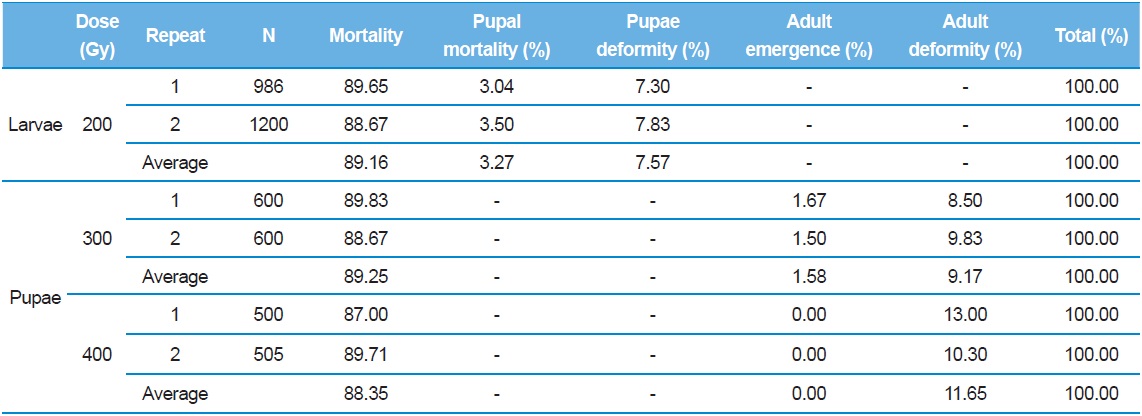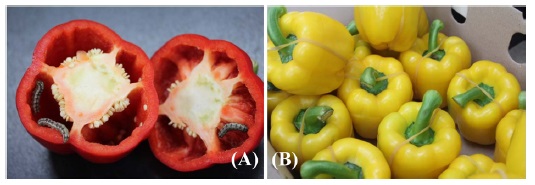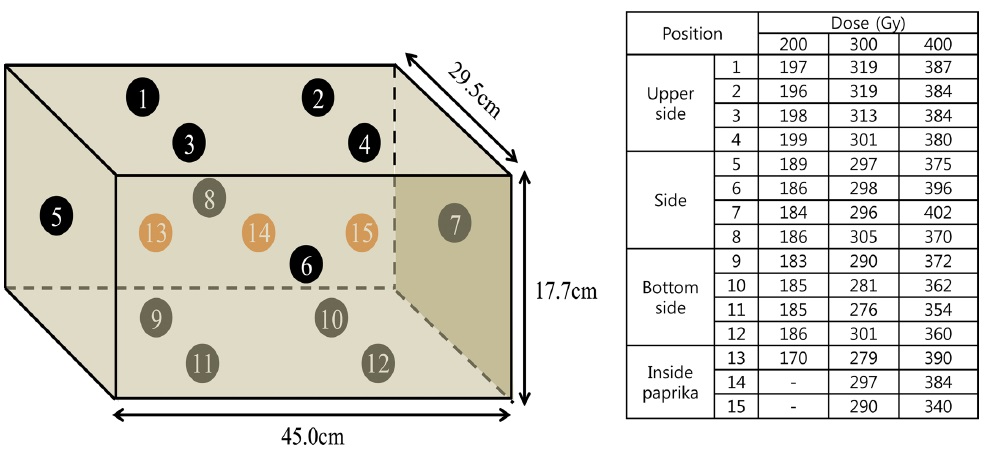



The oriental tobacco budworm,
According to the import-export phytosanitary regulation for quarantine in South Korea, a confirmatory test must be conducted with more than 1,000 individuals at the stage most resistant to phytosanitation (QIA, 2014). Among premature stages of
The oriental tobacco budworms used in these experiments were reared at Chonnam National University using a general-purpose, artificial diet for Lepidoptera (Bio-Serv, Frenchtown, NJ, USA). Details of the rearing condition and method were previously reported (Park
As a confirmatory experiment, with replication, two groups (986 and 1,200 individuals) of final-instar larvae, 17–20 d of age and approximately 4 cm in length, were irradiated with 200 Gy based on the results of the previous study. Additionally, two groups of 5- to 6-day-old pupae, 600 individuals in each, were irradiated with 300 Gy. At the 300-Gy dose, emergence of normal adults occurred. Thus, two additional pupae groups (500 and 505 individuals) were irradiated with an increased dose of 400 Gy. A cobalt-60 gamma irradiator at the Korea Atomic Energy Research Institute, Jeongeup, Korea (150 TBq capacity; ACEL, MDS, Nordion, Canada), was used for irradiation.
Paprika were halved using a sterilized knife, and five to six larvae or pupae were placed inside. Halves were then reassembled and secured with a rubber band to prevent escape. Boxes actually used for export (45 cm × 29.5 cm × 17.7 cm) were then filled with approximately 20 paprika (Fig. 1). After irradiation, to prevent damage from occasional paprika decay, the larvae and pupae were removed from the paprika and returned to their normal, artificial diet (Park
To determine the absorbed doses of gamma radiation within the paprika box, dose mapping was carried out using 13-15 alanine dosimeters with a diameter of 5 mm (Bruker Instruments, Rheinstetten, Germany) and a Bruker EMS 104 EPR analyzer (Bruker Instruments). The dosimeters were attached in a randomly selected box (Fig. 2), and the free-radical signals were measured.
Dose mapping results indicated that with irradiation of 200 Gy, the absorbed dose ranged from 170 to 199 Gy. The lowest and highest absorbed doses were found inside the paprika (no. 13) and in the upper region of the box (no. 4), respectively. The mean of the 13 alanine dosimeters was 188 Gy, and the dose uniformity ratio (represented by maximum per minimum) was 1.17. When the box was irradiated with 300 Gy, the absorbed dose ranged from 276 to 319 Gy. The lowest and the highest absorbed doses were found at the bottom of the box (no. 11) and the upper side of the box (nos. 1 and 2), respectively. The mean of the 15 alanine dosimeters was 297 Gy and the dose uniformity ratio (represented by maximum per minimum) was 1.16. When 400 Gy was used, the absorbed dose ranged from 340 to 402 Gy, with the lowest and highest absorbed doses found inside the paprika (no. 15) and at the right side of the box (no. 7), respectively. At this dose, the mean of the 15 alanine dosimeters was 376 Gy and the dose uniformity ratio (represented by maximum per minimum) was 1.14. Thus, overall, the absorbed doses inside the box are within the reasonable range, although local differences exist, as can be found in other studies (Follett and Lower, 2000; Zhan
After irradiation with 200 Gy, 10.84% of larvae survived, but they either formed abnormal pupae (7.57%) or died during the pupal stage (3.27%) (Table 1). Consequently, no normal adults emerged from larvae that received 200 Gy. The previous small-scale experiment had shown that for last-instar larvae, a radiation dose of 100 Gy caused larval or pupal death or emergence of abnormal adults; no normal adults developed (Park

Results of confirmatory test for irradiated paprika infected by last-instar larvae and pupae of Helicoverpa assulta
For pupae, a total of 1,200 individuals were irradiated with 300 Gy. On average, this led to 89.25% death and 9.17% emergence of abnormal adults. However, in 1.58%, adults emerged normally (Table 1). This result is in sharp contrast to the previous small-scale experiment in which complete prevention of adult emergence occurred at doses of 300 Gy or above (Park
In the subsequent experiment, to determine the dosage for complete prevention of normal adult emergence, a total of 1,005 larvae were irradiated with 400 Gy. On average, this dosage led to 88.35% death, 11.65% abnormal emergence, and no normal emergence (Table 1). In comparison with the previous small-scale experiment, both experiments achieved complete prevention of normal emergence with 400-Gy irradiation. However, the ratio of adult deformity increased in the current, larger-scale experiment as compared to the previous small-scale experiment (11.65% vs. 4.55%). By contrast, the ratio of pupal mortality decreased in the current study (88.35% vs. 95.45%) (Park


